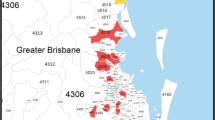Abstract
It is generally conceded that dividend pricing models are poor predictors of asset prices. This finding is sometimes attributed to excess volatility or to a dividend process manipulated by firm managers. In this paper, we present rather powerful panel tests of the dividend pricing relation using a unique data set in which dividends are set by market forces independent of managers' preferences. We rely on observations on the market for condominium dwellings in Korea—perhaps the only market in which information on dividends and prices is publicly and continuously available to consumers and investors. We extend the “dividend-price ratio model” to panels of housing returns and rents differentiated by type and location. We find broad support for the dividend pricing model during periods both before and after the Asian Financial Crisis of 1997–1998, suggesting that the market for housing assets in Korea has been remarkably efficient.
Similar content being viewed by others
References
Ackert L, Smith B (1993) Stock price volatility, ordinary dividends, and other cash flows to shareholders. J Finance 48:1147–1160
Ambrose BW, Kim S (2003) Modeling the Korean Chonsei Lease Contract. Real Estate Econ 31:53–74
Campbell J, Shiller R (1987) Cointegration and tests of present value models. J Polit Econ 95:1062–1088
Campbell J, and Shiller R (1988) The dividend-price ratio and expectation of future dividends and discount factors. Rev Financ Stud 1:195–228
Chang Y, Song W (2003) Panel unit root tests in the presence of cross sectional dependency and heterogeneity. Working paper, University of Houston
Craine R (1993) Rational bubbles: a test. Journal of Economic Dynamics and Control 17: 829–846
Diba B, Grossman H (1988) Explosive rational bubbles in stock prices? Am Econ Rev 78:520–530
Gilles C, LeRoy S (1991) Econometric aspects of the variance-bounds tests: a survey. Rev Financ Stud 4:753–791
Hamilton J (1994) Time series analysis. Princeton, NJ: Princeton University Press
Hamilton J, Whiteman C (1985) The observable implications of self-fulfilling expectations. J. Monet Econ 16:353–373
Kim S (2000) The structural changes in Korean housing market and new housing finance policy. Housing Studies Review 8:247–268
Kleidon A (1986) Variance bound tests and stock price valuation models. J Polit Econ 94:953–1001
LeRoy S (1989) Efficient capital markets and martingales. J Econ Lit 27(4):1583–1621
Marsh T, Merton R (1986) Dividend variability and variance bounds tests for the rationality of stock market prices. Am Econ Rev 76(3):483–498
Meese R, Wallace N (1994) Testing the present value relation for housing prices: should I leave my house in San Francisco? J Urban Econ 35:245–266
Poterba J (1984) Tax subsidies to owner-occupied housing: an asset market approach. Q J Econ 99:729–745
Son J, Won YH, Moon CG (2003) Changing conditions and quality of housing. Soc Indic Res 62:211–237
White H (1980) A heteroskedasticity-consistent covariance matrix estimator and a direct test for heteroskedasticity. Econometrica 48:817–838
Author information
Authors and Affiliations
Corresponding author
Rights and permissions
About this article
Cite this article
Hwang, M., Quigley, J.M. & Son, Jy. The Dividend Pricing Model: New Evidence from the Korean Housing Market. J Real Estate Finan Econ 32, 205–228 (2006). https://doi.org/10.1007/s11146-006-6798-3
Published:
Issue Date:
DOI: https://doi.org/10.1007/s11146-006-6798-3




